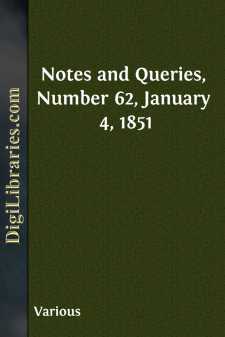Categories
- Antiques & Collectibles 13
- Architecture 36
- Art 48
- Bibles 22
- Biography & Autobiography 813
- Body, Mind & Spirit 142
- Business & Economics 28
- Children's Books 16
- Children's Fiction 13
- Computers 4
- Cooking 94
- Crafts & Hobbies 4
- Drama 346
- Education 46
- Family & Relationships 57
- Fiction 11829
- Games 19
- Gardening 17
- Health & Fitness 34
- History 1377
- House & Home 1
- Humor 147
- Juvenile Fiction 1873
- Juvenile Nonfiction 202
- Language Arts & Disciplines 88
- Law 16
- Literary Collections 686
- Literary Criticism 179
- Mathematics 13
- Medical 41
- Music 40
- Nature 179
- Non-Classifiable 1768
- Performing Arts 7
- Periodicals 1453
- Philosophy 64
- Photography 2
- Poetry 896
- Political Science 203
- Psychology 42
- Reference 154
- Religion 513
- Science 126
- Self-Help 84
- Social Science 81
- Sports & Recreation 34
- Study Aids 3
- Technology & Engineering 59
- Transportation 23
- Travel 463
- True Crime 29
Notes and Queries, Number 62, January 4, 1851
by: Various
Categories:
Description:
Excerpt
NOTES.
OLD BALLAD UPON THE "WINTER'S TALE."
Some of your correspondents may be able to give me information respecting an old ballad that has very recently fallen in my way, on a story similar to that of Shakspeare's Winter's Tale, and in some particulars still more like Greene's novel of Pandosto, upon which the Winter's Tale was founded. You are aware that the earliest known edition of Greene's novel is dated 1588, although there is room to suspect that it had been originally printed before that year: the first we hear of the Winter's Tale is in 1611, when it was acted at court, and it was not printed until it appeared in the folio of 1623.
The ballad to which I refer has for title The Royal Courtly Garland, or Joy after Sorrow: it is in ordinary type, and was "Printed and sold in Aldermary Churchyard, London." It has no date, and in appearance does not look older than from perhaps, 1690 to 1720; it may even be more recent, as at that period it is not easy to form a correct opinion either from typography or orthography: black-letter has a distinguishing character at various periods, so as to enable a judgment to be formed within, perhaps, ten years, as regards an undated production: but such is not the case with Roman type, or white-letter. What I suspect, however, is that this ballad is considerably older, and that my copy is only a comparatively modern reprint with some alterations; it requires no proof, at this time of day, to show that it was the constant habit of our old publishers of ephemeral literature to reprint ballads without the slightest notice that they had ever appeared before. This, in fact, is the point on which I want information, as to The Royal Courtly Garland, or Joy after Sorrow. Can any of your correspondents refer me to an older copy, or do they know of the existence of one which belongs to a later period? I cannot be ignorant of DR. RIMBAULT'S learning on such matters, and I make my appeal especially to him.
It is very possible that it may bear a different title in other copies, and for the sake of identification I will furnish a few extracts from the various "parts" (no fewer than six) into which the ballad is divided; observing that they fill a closely printed broadside, and that the production is entirely different from Jordan's versification of the Winter's Tale, under the title of The Jealous Duke and the injured Duchess, which came out in his Royal Arbor of Loyal Poesie, 8vo. 1664. It is singular that two ballads, hitherto wholly unknown, should have been written upon the same incidents of the same drama, although we are yet without evidence that Jordan's effusion was ever published as a broadside.
Not a single name is given to any of the persons in my Royal Courtly Garland, but the places of action are reversed exactly in the same way as in Greene's novel of Pandosto, where what Shakspeare represents as passing in Sicily occurs in Bohemia, and vice versa; moreover, the error of representing Bohemia as a maritime country belongs to my ballad, as well as to the novelist and the dramatist....












